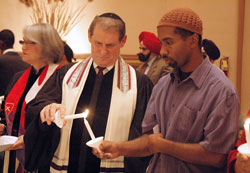Music fills cathedral during Interfaith Thanksgiving Service

Giora Sharon, center, the cantor and choir director for the Congregation Beth-El Zedeck synagogue in Indianapolis, lights a candle from the candle of Shakoor Siddeeq, the treasurer of the Nur Allah Islamic Center in Indianapolis, during the 11th annual Interfaith Thanksgiving Service on Nov. 23 at SS. Peter and Paul Cathedral in Indianapolis. (Photo by Sean Gallagher)
By Sean Gallagher
Music from religious traditions around the world echoed in SS. Peter and Paul Cathedral in Indianapolis on Nov. 23 during the 11th annual Interfaith Thanksgiving Service.
Wearing their colorful native dress, members of the Sikh and Hindu communities in Indianapolis sang hymns in their sacred languages while being accompanied by harmoniums, drums and finger cymbals.
Representatives of the Muslim and Buddhist communities in central Indiana chanted prayers in Arabic and Tibetan.
And the Indianapolis Children’s Choir, and choirs from SS. Peter and Paul Cathedral Parish and the Congregation Beth-El Zedek synagogue, sang choral settings of prayers of thanksgiving to God during the service, which was presided over by Archbishop Daniel M. Buechlein and co-sponsored by the Cathedral Parish and the Christian Theological Seminary in Indianapolis. (Related: See photo gallery here)
“God loves music. … He loves chanting,” said K.P. Singh, a representative of the Sikh Satsang of Indianapolis. “He loves people to come and praise him, and honor [him] without condition and in deepest reverence and spirit. And that’s why … music, incense, prayer [and] chanting are an integral part of every tradition.”
It is a part of the Muslim prayer tradition, too, said Shakoor Siddeeq, the treasurer of Nur Allah Islamic Center in Indianapolis.
“As a Muslim, there’s a specific way that you recite [a prayer],” Shakoor said. “It has a certain rhythm and pronunciation. It goes up and down [in pitch]. You don’t just read it. You chant it … in a certain rhythm.”
The fact that so many religious traditions around the world use music, Shakoor said, is because it touches something deep in the human soul.
“Your heart has a rhythm,” he said.
Before moving to the United States, Giora Sharon was exposed to Muslim forms of prayer after living for 20 years in Israel. But participating in every Interfaith Thanksgiving Service has broadened the Congregation Beth-El Zedek cantor and choir director’s view on the world and on music.
“I never knew about the Sikh community until I met them here,” said Sharon before the service. “It’s also very interesting when I hear the Hindus worship in their own way. Music is the language that everybody understands. Everybody can speak it. I wish the world would be led by musicians and not by politicians.”
During the service, Sharon’s deep baritone voice filled the cathedral as he sang a setting of Psalm 30 in its original Hebrew.
His love of music was reflected in the words of that psalm: “You transformed by mourning into dancing, my sackcloth into robes of joy that I might sing your praise unceasingly, that I might thank you, Lord my God, forever” (Ps 30:12-13).
Many of the sung prayers at the Interfaith Thanksgiving Service were prayers of gratitude for God’s blessings. This was also the subject of a reflection given during the service by the Rev. Richard Spleth, the regional minister for the Christian Church (Disciples of Christ) in Indiana.
“[Giving thanks] just makes God happy,” Spleth said. “We know that God is going to provide for us, regardless. It is who God is. It is what God does. But I think God simply revels in hearing our thanksgivings.”
Father John Beitans, the director of the archdiocesan Office of Ecumenism, was thankful that the cathedral, following the lead of Pope John Paul II and Pope Benedict XVI, has hosted the Interfaith Thanksgiving Service for so many years.
“It shows that the archdiocese takes it seriously, and that our Cathedral Parish sees as part of its mission … to reach out to all other denominations and religious groups,” he said. “As a priest of the archdiocese, I take such pride in that. It gives the Church a very, very wonderful aroma of being welcoming and beautiful.” †
